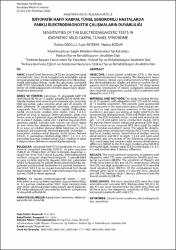SENSITIVITIES OF THE ELECTRODIAGNOSTIC TESTS IN IDIOPATHIC MILD CARPAL TUNNEL SYNDROME
Abstract
OBJECTIVE: Carpal tunnel syndrome (CTS) is the most common entrapment neuropathy. The diagnosis is based on the history, clinical signs and symptoms of the patient, but electrodiagnostic studies are done to confirm the di- agnosis and to manage the treatment. This study aimed to assess sensitivities of clinical symptoms, provocative tests and electrodiagnostic studies (EDS) in patients with idiopathic mild CTS. MATERIAL AND METHODS:The study included 90 han- ds of 75 patients with idiopathic mild CTS and 30 hands of 15 healthy volunteers. The patients were questioned for symptoms in the innervation area of the median ner- ve such as pain, paresthesia, weakness in the hand and numbness and pain worsening at night, relief from the symptoms by shaking hands. Tinel and Phalen tests were done. The EDS included; motor, mixed and sensorial (di- gits 1-2-3-4 and palm) nerve conduction studies (NCS) for median nerve; motor, mixed and sensorial (fifth digit) NCS for ulnar nerve, sensorial NCS (first digit) for radial nerve, median and ulnar F waves. The values for distal la- tency and nerve conduction velocity (NCV) were calcula- ted for all studied nerves. Sensitivities of median sensory distal latency and NCV to digits 1,2,3,4 and palm-wrist segments and sensitivities of the following comparative tests were detected; median-radial sensory distal latency difference (SDLD) to the first digit, median-ulnar SDLD to the fourth digit, median-ulnar SDLD to the digits 2-5, 3-5, 4-5 and median-ulnar F latency difference. RESULTS: The most common symptoms in patients with idiopathic mild CTS were paresthesia (95.6%) and noc- turnal numbness (88.8%). The sensitivity of Phalen’s and Tinel’s tests were 67.8% and 56.7%, respectively. Among the EDS, first digit and palm-wrist sensorial NCV were the most sensitive tests (98.9%). Of the comparative tests, median-ulnar SDLD to digits 4-5 was the most sensitive one (93.3%). Median-ulnar F latency difference had the lowest sensitivity (38.9%). CONCLUSIONS: The most sensitive EDS were first digit and palm-wrist sensorial NCV. Median-ulnar SDLD to di- gits 4-5 was more sensitive than the other tests. With use of these tests, the diagnostic sensitivity of EDS may be increased in patients with mild CTS. AMAÇ: Karpal Tünel Sendromu (KTS) en sık görülen tuzak nöropatisidir. Tanısı klinik bulgularla ile konulabilir, ancak tanıyı doğrulamak ve tedaviyi planlamak için elektrodiag- nostik çalışmalara ihtiyaç vardır. Bu çalışmada, idiyopatik hafif KTS’li hastalarda klinik semptomlar ve provokatif testler ile elektrodiagnostik testlerin duyarlılığını değer- lendirmek amaçlandı. GEREÇ VE YÖNTEM: Çalışmaya 75 idiyopatik hafif KTS tanılı hasta (90 el) ve 15 sağlıklı gönüllü (30 el) alındı. Has- talarda median sinir innervasyon alanında ağrı, parestezi, elde güçsüzlük, uyku sırasında artan ağrı ve uyuşma ile elleri silkeleme ile şikayetlerde rahatlama semptomları sorgulandı; Tinel ve Phalen testleri yapıldı. Elektrodiag- nostik incelemede; median sinir motor, miks, 1-2-3-4. parmak ve avuç içi duyusal iletim çalışmaları, ulnar sinir motor, miks ve 5.parmak duyusal iletim çalışmaları, medi- an ve ulnar F dalgası, radial sinir 1.parmak duyusal iletim çalışması yapıldı. Çalışılan tüm sinirler için distal latans ve sinir iletim hızı değerleri hesaplandı. Parmak (1, 2, 3, 4) ve avuç içi median duyusal distal latansları ve iletim hızlarının; karşılaştırmalı elektrodiagnostik testlerden 1. parmaktan median-radial duyusal distal latans farkının (DDLF), 4. parmaktan median-ulnar DDLF, 2-5, 3-5, 4-5. parmaklar arasında median-ulnar DDLF; median ve ulnar F dalgası latans farklarının duyarlılığı hesaplandı. BULGULAR: İdiyopatik hafif KTS’li hastalarda en sık rast- lanan iki semptom parestezi (%95.6) ve gece uyuşması (%88.8) idi. Phalen testi ve Tinel testlerinin duyarlılığı sı- rasıyla %67.8 ve %56.7 olarak bulundu. Elektrodiagnostik testlerin sonuçları değerlendirildiğinde, 1.parmak-bilek ve avuç içi-bilek segmenti duyusal iletim hızı çalışmaları %98.9 ile duyarlılığı en yüksek testler olarak bulundu. Uy- gulanan karşılaştırmalı testlerden 4-5.parmak median-ul- nar DDLF %93.3 ile en duyarlı karşılaştırmalı test olarak tespit edildi. Median-ulnar F latans farkı duyarlılığı en dü- şük test (%38.9) olarak saptandı. SONUÇ: En duyarlı elektrodiagnostik testler 1. par- mak-bilek ve avuç içi-bilek segmenti duyusal iletim hızıy- dı. 4-5 parmak median-ulnar DDLF diğer karşılaştırmalı sinir iletim çalışmalarından daha duyarlı olarak bulundu. KTS elektrodiagnostik tanısında bu testlerin kullanılması ile duyarlılık arttırılabilir.
















